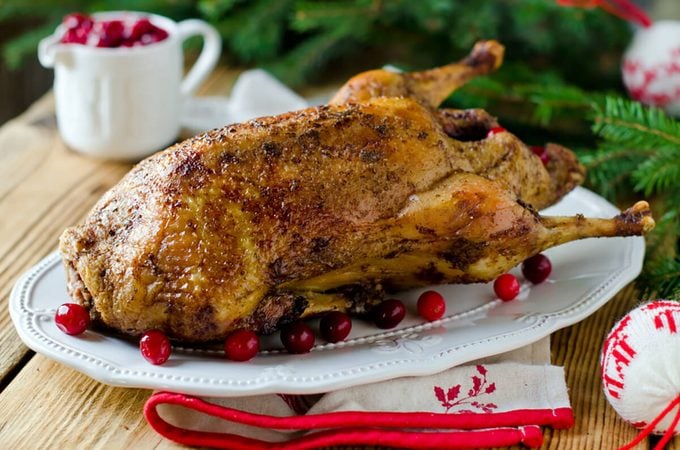Here’s What Happened to the Christmas Goose
Updated: Feb. 22, 2024
Over the past few decades, the ever-popular Christmas goose has disappeared from most families' menus. Here's what people are eating instead.

The most wonderful time of year is right around the corner, which means now’s the best time to break out the decorations, finalize your wish list and dream up the perfect festive feast. From Christmas cookies to homemade eggnog to crispy potato latkes (if you want to branch out or if Hanukkah is your celebration), the holiday season has no shortage of delicious dishes. But in the past few decades, the ever-popular Christmas goose has disappeared from most families’ menus.
So what gives? What happened to the Christmas goose? What’s its replacement? What even is a Christmas goose? We’re breaking it down for you here.
What’s a Christmas goose?
This holiday season, you probably won’t spring for goose at a nearby grocery store or restaurant, but it was the poultry of choice for centuries. Long ago in the old country, roast goose was the centerpiece for Michaelmas, a popular feast day in the Middle Ages, and before that, tradition says, it was offered as a sacrifice to the gods Odin and Thor.
So a Christmas goose is just a goose by any other name, right? Not exactly. Domestic geese are most delicious at two times of year—when they’re young in the early summer and toward the end of the year when they’re fattest—the second being precisely why they were such Christmas commodities. Similar to a Thanksgiving turkey, geese require a couple of hours to fully cook and are usually roasted in a pan filled with spices and citrus. They are all dark meat, rich and flavorful, and some prefer the flavor and moistness of the bird.
Want to make your own Christmas goose? Try this mouthwatering recipe.
What happened to the Christmas goose?
No, it’s not your imagination: The Christmas goose is less and less a holiday staple. Especially in the U.S., many have never come across one on the dinner table. While there’s no official reason behind its decline, we do have some theories. Believe it or not, many people blame Charles Dickens. In A Christmas Carol, Dickens associated goose with the struggling Cratchit family, turning it into a poor man’s supper.
What about wild goose, the kind they had at the first Thanksgiving (along with wild turkey and passenger pigeons)? If you live in the U.S., eating Canada geese may be unlawful. In some parts of the country, geese are intentionally killed to shrink the population and reduce the danger of airplane collisions. But there’s no protocol for testing slaughtered geese for toxins, so they end up in landfills instead of in your dining room.
Another hunch is the rise of agricultural technology in the 20th century made it easier and more affordable to buy other meats. Which brings us to…
What’s next?
Scoot over, Christmas goose—today, the holidays are all about roast turkey. While the United Kingdom links the increasing popularity of Christmas turkey to the rise of refrigerators after World War II, pinpointing the praised poultry’s Christmas dinner domination in the U.S. is easier said than done. But here’s what we know for sure: The 1940s saw a turkey breeding boom, which meant some farms were raising millions of birds each year.
Not only were there tons of turkeys for Christmas and Thanksgiving, they were cheaper, too. A 10-pound goose ordered online today can cost over $15.00 a pound, more than most of us want to pay. Compared to spiral ham, which cost $2.91 per pound in 2014, turkey clocked in at a cool $1.28. In 2012, Americans ate an estimated 22 million turkeys on Christmas Day; we suspect the number has gone up.
Now that you have your main course settled, it’s time to get into the holiday spirit. Whether you’re hosting a round of white elephant or want to add some pizzazz to your dining table, we’re here to make sure this year’s festivities are ones for the books.




















